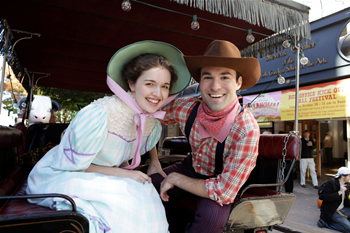The long reverberation time of Duke University Chapel is challenging to any conductor and few can be said to have mastered it as well as Rodney Wynkoop, artistic director of the splendid Choral Society of Durham. (He also conducts the Duke University Chorale and the Duke Chapel Choir as well as the Vocal Arts Ensemble of Durham, an elite chamber choir.) Wynkoop’s fascinating program for the Choral Society’s season finale paired the Mass No. 13 in B-flat (Creation) by Franz Joseph Haydn (1732-1809) with Fynsk Forår (“Springtime on Funen”) by Carl Nielsen (1865-1931). leavened by a medley of short pieces showcasing the enthusiastic talents of the Durham Children’s Choir. The Choral Society’s polished ad hoc orchestra was made up of current and retired members of the North Carolina Symphony and other Piedmont orchestras and free-lancers and was lead by Ciompi String Quartet first violinist Eric Pritchard as concertmaster.
Haydn composed the outstanding last six of his masses, in which he experimented with a new approach to the established old form, between 1796 and 1802. Traditionally these have been assumed to have been the result of a commission to deliver a mass for the annual celebrations of the name-day of Princess Marie Hermenegild Esterházy who unlike her husband Prince Nicolaus II, shared the enthusiasm of her father-in-law for Haydn. His orchestral scoring for the masses is notable for its musical unity and fuller symphonic use of the instruments. Solo instruments have their own melodic lines besides reinforcing voices. Soloists are used more often as a quartet or duo than as stand-alone vocalists. Orchestral color and dynamics are skillfully used to bring out the drama of the texts.
Haydn’s penultimate Mass – No. 13 in B-flat – has the nickname Creation because of the composer’s little joke of recycling music from Adam and Eve’s final duet from his Creation Oratorio for the words “Qui tollis peccata mundi.” To a jaunty theme in the horns borrowed from the oratorio, “The dew-freshened morning, o bright awaking,” with its sensual implications, accompanies the bass’ “You who take away the sins of the world.” The Empress Marie was NOT amused and she insisted Haydn recompose the offending passage in her copy of the score!
Wynkoop led a textually clear and vital performance of the Creation Mass. His tempos allowed the listener to follow nearly every word of the Latin text sung by the full choir whether in faster or slower passages across a wide range of dynamics. Hall resonance helped add weight to hushed choral passages without muddying the words. Blending of the chorus and orchestra provided a wide palette of tonal color. Wynkoop’s quartet of soloists, drawn from within the choir, sang from both in front of the orchestra and from back, within the choir. Their diction and vocal projection were more than adequate, and the voices blended very well as either four singers or in the duets. The quartet consisted of soprano Kristen Blackman, alto Laura Jones, tenor Jeremy Nabors, and bass Michael Lyle. Jones has firm lower range and Nabors brought welcome warmth of tone that melded well with his colleagues’ voices. Soprano Rosalynde Robertson and tenor Bradley Naylor were additional soloists within the “Gloria.” The orchestra’s fine quality was displayed in an interlude between the choral sequence and the tenor solo within the “Credo.” Concertmaster Eric Pritchard’s finely honed solo was a feature of the “Sanctus.” Both the woodwinds and the brass were strongly characterized and played with great subtlety.
The Durham Children’s Choir was featured in six short selections. Scott Hill directed the first two selections, “Butterfly” and “On an Eagle’s Wing” from Songs of Flight by Andy Beck. The surprisingly accomplished accompanist was Christopher Camaitta, a student from within the choir. Dena Byers led the children in “Sakura,” a Japanese folk song arranged by Michael Scott. The divided choir portions, during the repeat, were done with admirable clarity. Byers played the tambourine and regular piano accompanist Vangie Poe played the triangle to provide percussion for a catchy setting of “La Violette,” an Acadian folksong, arranged by Susan Brumfield and led by Hill. Byers led the ensemble for “A Song to End All War” by David Brunner. Hill led children in the “Chorus of Street Urchins” from Bizet’s Carmen in an English arrangement by Mary Schell Hoke Bacon. The children’s crisp bright red uniforms contrasted with their lively delivery of the beloved military march of ragamuffins.
Music by Scandinavian composers is even more rarely performed than French music in this region. It was a rare and welcome treat for Wynkoop to chose Nielsen’s Fynsk Forår (Springtime on Funen), Op. 42. Susan Dakin’s excellent program notes for this concert were essential reading for this rarely-heard work. Like the Haydn’s Latin text, both the original Danish and English translations were given. Nielsen’s Muse was reluctant to tackle the text by Aage Berntsen, “the winning entry in a competition announced in 1917 by the Danish Choral Society for a work about Danish history or landscape” to be composed by Nielsen. Apparently the Funen islanders were well-known for not taking themselves too seriously, and the composer was inspired to create music of great lyricism and simplicity. Eventually I caught up with the choir in the text and from the soprano solo, “Å se nu kommer våre” (“Ah look, now comes spring”) on, was able to follow both soloists and ensemble relatively easily, unusual vowels aside. Further soloists from the choir were soprano Elizabeth Terry, tenor Bradley Naylor, Brent Blakesley, bass Michael Lyle. Two trebles from the Durham Children’s Choir, Gretchen Mario and Grey Lehman, acquitted themselves confidently in “Den Blind Spillemand” (“The Blind Musician”), as did the whole children’s ensemble in their portions. The a cappella portion for adult men’s voices, “De Gamle” (“The Old People”), was very impressive. Clarinetist Jimmy Gilmore and bassoonist John Christopher Ulffers had splendid solos within the finale, “Dansevisen” (“The Dance song”).











